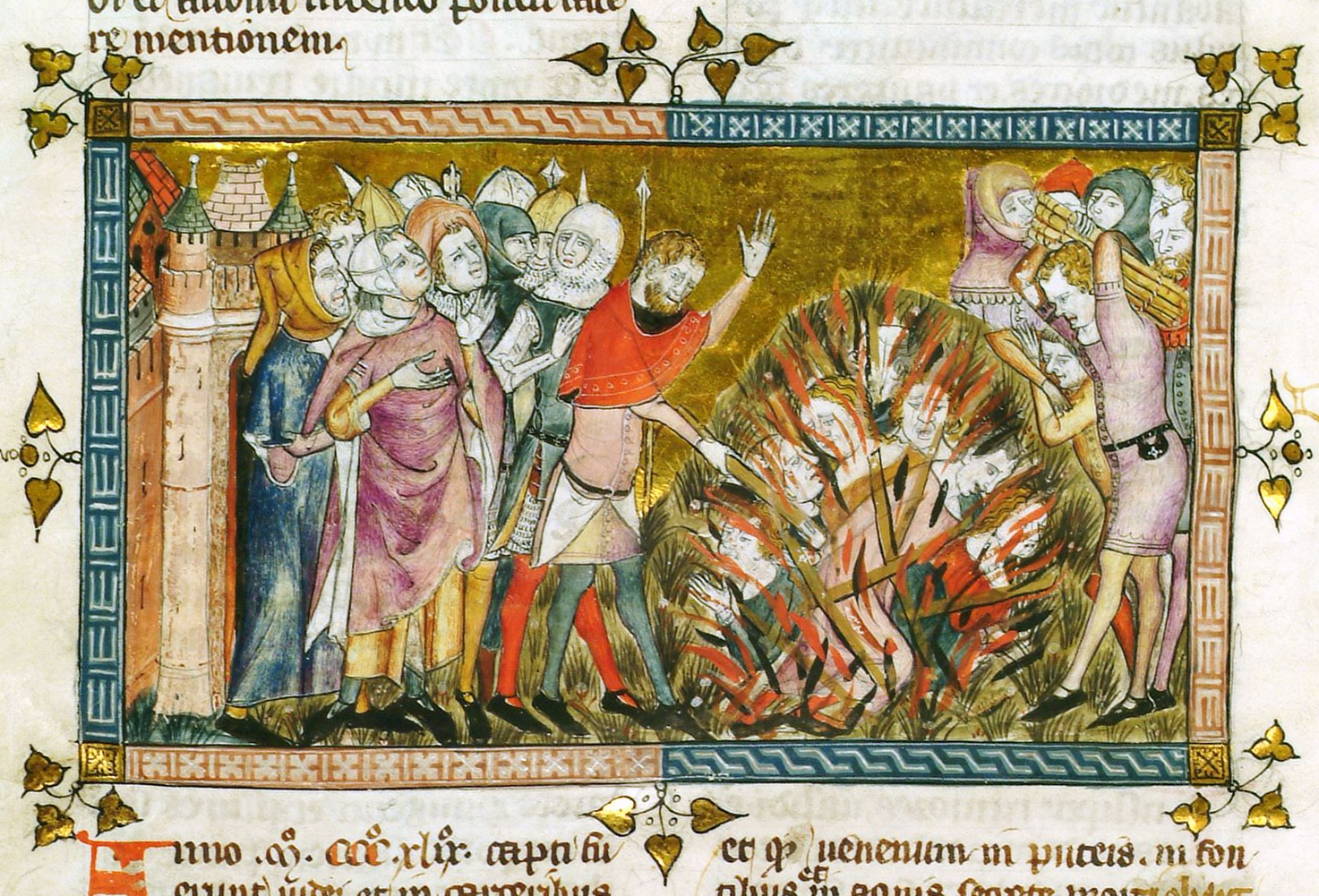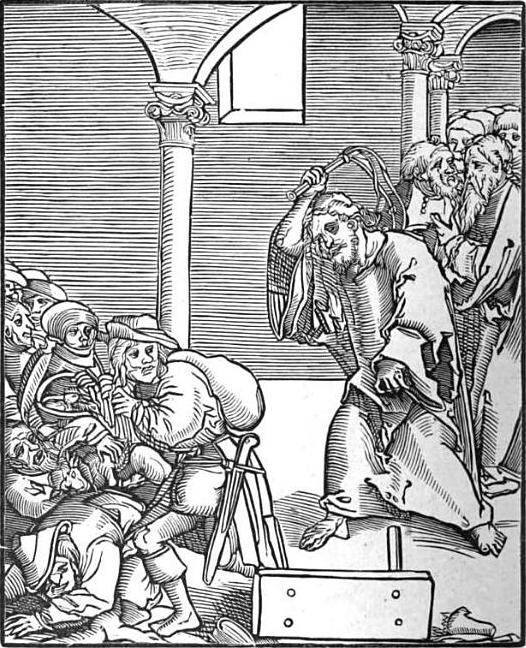|
Medieval Antisemitism
Antisemitism in the history of the Jews in the Middle Ages became increasingly prevalent in the Late Middle Ages. Johannes, Fried (2015) p. 287-289 The Middle Ages. Cambridge, Massachusetts: Harvard University Press. Early instances of pogroms against Jews are recorded in the context of the First Crusade. Expulsions of Jews from cities and instances of blood libel became increasingly common from the 13th to the 15th century. This trend only peaked after the end of the medieval period, and it only subsided with Jewish emancipation in the late 18th and 19th centuries. Accusations of deicide In the Middle Ages, religion played a major role in fueling antisemitism. Even though it is not a part of Roman Catholic dogma, many Christians, including many members of the clergy, have held the Jewish people collectively responsible for the killing of Jesus, through the so-called blood curse of Pontius Pilate in the Gospels, among other things. As stated in the Boston College Guide to P ... [...More Info...] [...Related Items...] OR: [Wikipedia] [Google] [Baidu] |
Antisemitism
Antisemitism or Jew-hatred is hostility to, prejudice towards, or discrimination against Jews. A person who harbours it is called an antisemite. Whether antisemitism is considered a form of racism depends on the school of thought. Antisemitic tendencies may be motivated primarily by negative sentiment towards Jewish peoplehood, Jews as a people or negative sentiment towards Jews with regard to Judaism. In the former case, usually known as racial antisemitism, a person's hostility is driven by the belief that Jews constitute a distinct race with inherent traits or characteristics that are repulsive or inferior to the preferred traits or characteristics within that person's society. In the latter case, known as religious antisemitism, a person's hostility is driven by their religion's perception of Jews and Judaism, typically encompassing doctrines of supersession that expect or demand Jews to turn away from Judaism and submit to the religion presenting itself as Judaism's suc ... [...More Info...] [...Related Items...] OR: [Wikipedia] [Google] [Baidu] |
Pope Paul VI
Pope Paul VI (born Giovanni Battista Enrico Antonio Maria Montini; 26 September 18976 August 1978) was head of the Catholic Church and sovereign of the Vatican City State from 21 June 1963 until his death on 6 August 1978. Succeeding John XXIII, he continued the Second Vatican Council, which he closed in 1965, implementing its numerous reforms. He fostered improved ecumenical relations with Eastern Orthodox and Protestant churches, which resulted in many historic meetings and agreements. In January 1964, List of pastoral visits of Pope Paul VI, he flew to Jordan, the first time a reigning pontiff had left Italy in more than a century. Montini served in the Holy See's Secretariat of State from 1922 to 1954, and along with Domenico Tardini was considered the closest and most influential advisor of Pope Pius XII. In 1954, Pius named Montini Archbishop of Milan, the largest Italian diocese. Montini later became the Secretary of the Episcopal Conference of Italy, Italian Bishops' Co ... [...More Info...] [...Related Items...] OR: [Wikipedia] [Google] [Baidu] |
Well Poisoning
Well poisoning is the act of malicious manipulation of potable water resources in order to cause illness or death, or to deny an opponent access to fresh water resources. Well poisoning has been historically documented as a strategy during wartime since antiquity, and was used both offensively (as a terror tactic to disrupt and depopulate a target area) and defensively (as a scorched earth tactic to deny an invading army sources of clean water). Rotting corpses (both animal and human) thrown down wells were the most common implementation; in one of the earliest examples of biological warfare, corpses known to have died from common transmissible diseases of the Pre-Modern era such as bubonic plague or tuberculosis were especially favored for well-poisoning. History of implementation Instances of medieval usage Well poisoning has been used as an important scorched earth tactic at least since medieval times. In 1462, for example, Prince Vlad III the Impaler of Wallachia u ... [...More Info...] [...Related Items...] OR: [Wikipedia] [Google] [Baidu] |
Scapegoating
Scapegoating is the practice of singling out a person or group for unmerited blame and consequent negative treatment. Scapegoating may be conducted by individuals against individuals (e.g., "he did it, not me!"), individuals against groups (e.g., "I couldn't see anything because of all the tall people"), groups against individuals (e.g., "He was the reason our team didn't win"), and groups against groups. A scapegoat may be an adult, child, sibling, employee, or peer, or it may be an ethnic, political or religious group, or a country. A whipping boy, identified patient, or fall guy are forms of scapegoat. Scapegoating has its origins in the scapegoat ritual of atonement described in chapter 16 of the Biblical '' Book of Leviticus'', in which a goat (or ass) is released into the wilderness bearing all the sins of the community, which have been placed on the goat's head by a priest. At the individual level A medical definition of scapegoating is: Scapegoated groups throu ... [...More Info...] [...Related Items...] OR: [Wikipedia] [Google] [Baidu] |
Plague (disease)
Plague is an infectious disease caused by the bacterium '' Yersinia pestis''. Symptoms include fever, weakness and headache. Usually this begins one to seven days after exposure. There are three forms of plague, each affecting a different part of the body and causing associated symptoms. Pneumonic plague infects the lungs, causing shortness of breath, coughing and chest pain; bubonic plague affects the lymph nodes, making them swell; and septicemic plague infects the blood and can cause tissues to turn black and die. The bubonic and septicemic forms are generally spread by flea bites or handling an infected animal, whereas pneumonic plague is generally spread between people through the air via infectious droplets. Diagnosis is typically by finding the bacterium in fluid from a lymph node, blood or sputum. Those at high risk may be vaccinated. Those exposed to a case of pneumonic plague may be treated with preventive medication. If infected, treatment is with antibiotics a ... [...More Info...] [...Related Items...] OR: [Wikipedia] [Google] [Baidu] |
Black Death
The Black Death was a bubonic plague pandemic that occurred in Europe from 1346 to 1353. It was one of the list of epidemics, most fatal pandemics in human history; as many as people perished, perhaps 50% of Europe's 14th century population. The disease is caused by the Bacteria, bacterium ''Yersinia pestis'' and spread by Flea, fleas and through the air. One of the most significant events in European history, the Black Death had far-reaching population, economic, and cultural impacts. It was the beginning of the second plague pandemic. The plague created religious, social and economic upheavals, with profound effects on the course of European history. The origin of the Black Death is disputed. Genetic analysis suggests ''Yersinia pestis'' bacteria evolved approximately 7,000 years ago, at the beginning of the Neolithic, with flea-mediated strains emerging around 3,800 years ago during the late Bronze Age. The immediate territorial origins of the Black Death and its outbreak ... [...More Info...] [...Related Items...] OR: [Wikipedia] [Google] [Baidu] |
Usury
Usury () is the practice of making loans that are seen as unfairly enriching the lender. The term may be used in a moral sense—condemning taking advantage of others' misfortunes—or in a legal sense, where an interest rate is charged in excess of the maximum rate that is allowed by law. A loan may be considered usurious because of excessive or abusive interest rates or other factors defined by the laws of a state. Someone who practices usury can be called a ''usurer'', but in modern colloquial English may be called a ''loan shark''. In many historical societies including ancient Christian, Jewish, and Islamic societies, usury meant the charging of interest of any kind, and was considered wrong, or was made illegal. During the Sutra period in India (7th to 2nd centuries BC) there were laws prohibiting the highest castes from practicing usury. Similar condemnations are found in religious texts from Buddhism, Judaism ('' ribbit'' in Hebrew), Christianity, and Islam (''rib ... [...More Info...] [...Related Items...] OR: [Wikipedia] [Google] [Baidu] |
Hebrew Bible
The Hebrew Bible or Tanakh (;"Tanach" . '' Random House Webster's Unabridged Dictionary''. ; ; or ), also known in Hebrew as (; ), is the canonical collection of scriptures, comprising the Torah (the five Books of Moses), the Nevi'im (the Books of the Prophets), and the [...More Info...] [...Related Items...] OR: [Wikipedia] [Google] [Baidu] |
Torah
The Torah ( , "Instruction", "Teaching" or "Law") is the compilation of the first five books of the Hebrew Bible, namely the books of Genesis, Exodus, Leviticus, Numbers and Deuteronomy. The Torah is also known as the Pentateuch () or the Five Books of Moses. In Rabbinical Jewish tradition it is also known as the Written Torah (, ). If meant for liturgic purposes, it takes the form of a Torah scroll ( '' Sefer Torah''). If in bound book form, it is called '' Chumash'', and is usually printed with the rabbinic commentaries (). In rabbinic literature, the word ''Torah'' denotes both the five books ( "Torah that is written") and the Oral Torah (, "Torah that is spoken"). It has also been used, however, to designate the entire Hebrew Bible. The Oral Torah consists of interpretations and amplifications which according to rabbinic tradition have been handed down from generation to generation and are now embodied in the Talmud and Midrash. Rabbinic tradition's underst ... [...More Info...] [...Related Items...] OR: [Wikipedia] [Google] [Baidu] |
Consequentialism
In moral philosophy, consequentialism is a class of normative, teleological ethical theories that holds that the consequences of one's conduct are the ultimate basis for judgement about the rightness or wrongness of that conduct. Thus, from a consequentialist standpoint, a morally right act (including omission from acting) is one that will produce a good outcome. Consequentialism, along with eudaimonism, falls under the broader category of teleological ethics, a group of views which claim that the moral value of any act consists in its tendency to produce things of intrinsic value.Teleological Ethics " '' ... [...More Info...] [...Related Items...] OR: [Wikipedia] [Google] [Baidu] |








